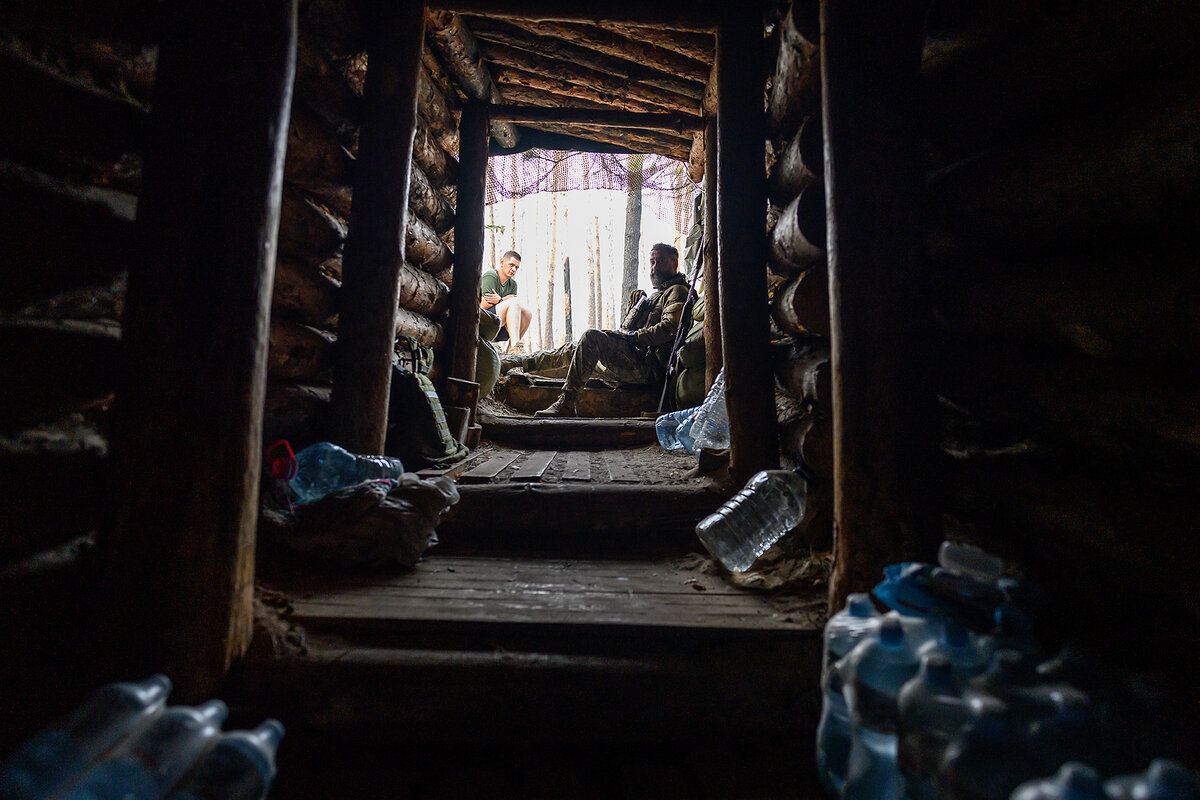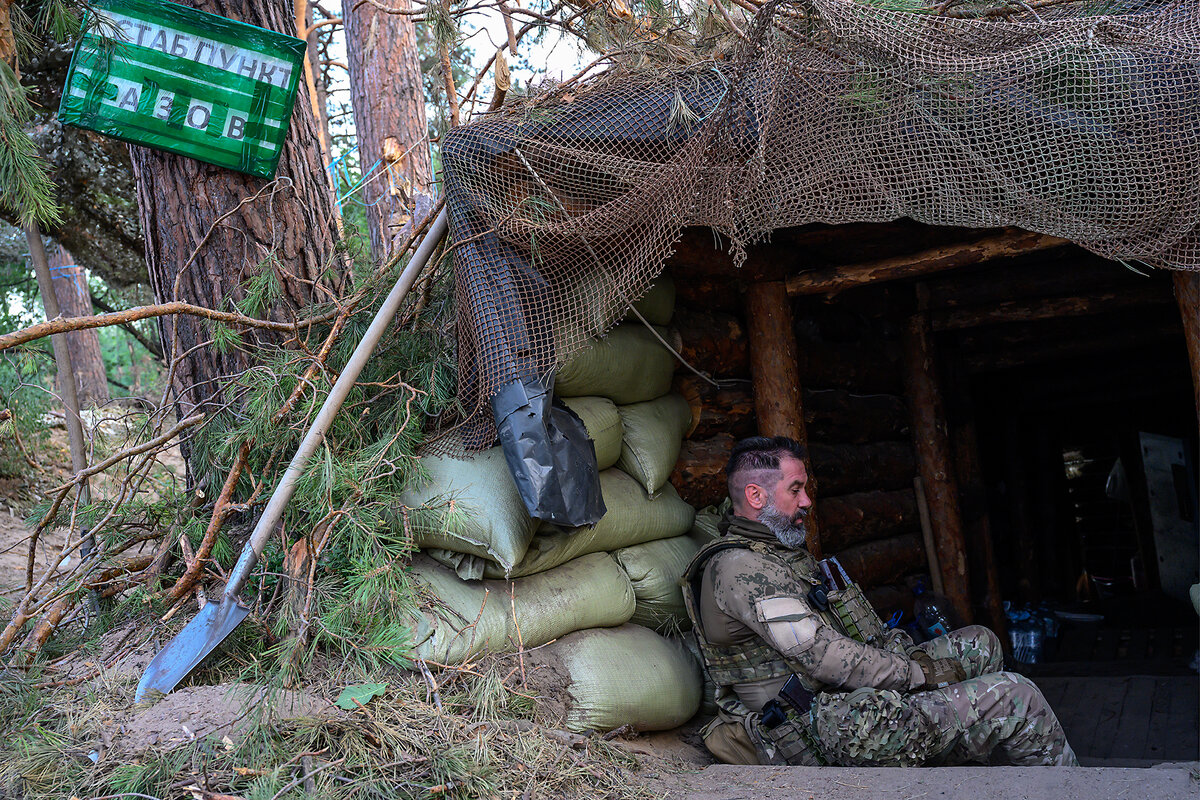Ukraine’s nationalist Azov fighters, once sanctioned by US, strive to clear name
| KREMINNA FOREST, UKRAINE
For the Azov team awaiting front-line casualties in its fortified dugout, the conversation shifts from paramedic chitchat to a dramatic change in U.S. policy that lifted restrictions on the fighting unit.
It’s a critical development for a brigade whose controversial antecedent included members with links to far-right groups and alleged neo-Nazi sympathies. But in June, a U.S. State Department vetting process found “no evidence” that Azov had engaged in gross human rights violations, allowing Azov fighters to participate in Western training and use weapons purchased with U.S. funds.
Why We Wrote This
A story focused onUkraine’s Azov Brigade has been much maligned, especially by Russia, for a Nazi-tainted past. But today its renowned fighters proudly and emphatically assert their modern self-definition as patriotic nationalists with a broad appeal.
Azov reached legendary status across Ukraine for the against-all-odds defense of Mariupol in 2022. The soldier-medics in the dugout blame Russian propaganda for maligning their brigade, and say that right-wing connections of early Azov members diminished years ago and are not relevant.
Today Azov units include Jews, Muslims, and other Ukrainian minorities.
“It’s very important to tell about Azov,” says anesthetist Roman Shtybel, who says he has never heard or “felt” neo-Nazi inclinations in Azov.
“We have this idea of the Ukrainian nation, like keeping and preserving Ukrainian nationality,” says an Azov soldier who declined to be named. “That is what we fight for. ... We take everyone who feels they are Ukrainian – this is the most important.”
For the Azov Brigade team awaiting front-line casualties in its fortified dugout, the day begins at dawn with a barrage of seven Russian missiles and then seven Grad rockets.
The barrage starts fires that must be put out.
“Now we spend more time as firefighters,” quips anesthetist Roman Shtybel, at this first stop for Ukrainian soldiers severely wounded on the front line. Hours after the Russian attack, some fires still smolder, and smoke filters among the tall pines in eastern Ukraine’s Kreminna Forest.
Why We Wrote This
A story focused onUkraine’s Azov Brigade has been much maligned, especially by Russia, for a Nazi-tainted past. But today its renowned fighters proudly and emphatically assert their modern self-definition as patriotic nationalists with a broad appeal.
Inside the bunker, its thick log ceiling protecting three small treatment stretchers and its walls hung with lifesaving trauma gear, the conversation ranges. First, it focuses on paramedic chitchat: the evolution of wound types as Ukraine’s war has ground on more than 2 1/2 years, and the fact that this unit can provide blood transfusions, just 6.5 kilometers (4 miles) from the front.
But the 12th Special Forces Azov Brigade is no typical Ukrainian unit, and talk soon shifts to a dramatic change in U.S. policy. In June, the United States lifted restrictions on Azov receiving American weapons and training.
It’s a critical development for a brigade whose controversial antecedent – founded in 2014 as a volunteer militia – included members with links to far-right groups and alleged neo-Nazi sympathies.
In 2018, the House of Representatives imposed restrictions on the Azov Battalion, a predecessor to the Azov Brigade, with some lawmakers citing neo-Nazi connections.
But in June, a separate State Department vetting process under Leahy laws found “no evidence” that Azov had engaged in gross human rights violations. It also reportedly found that the 2018 congressional restrictions did not apply to the reorganized and renamed brigade. That opened the way for Azov fighters to take part in Western training exercises and to use weapons purchased with U.S. funds.
The brigade’s reassessed status was not news to these soldier-medics, who say that right-wing connections of early Azov members diminished years ago and are not relevant today. They are proud, they say, to be part of a unit that is now renowned in Ukraine for its fighting prowess, fearlessness, and reputation for taking care of its own.
Russian accusations called propaganda
They dismiss as Russian propaganda accusations that Azov is part of what President Vladimir Putin calls the “neo-Nazi Kyiv regime.” It’s a canard, they say, that Moscow used in 2014 to justify annexing Ukraine’s Crimean Peninsula and justify supporting separatist militias in eastern Ukraine, and used again in February 2022 to justify the all-out invasion of Ukraine to “de-nazify” its southwestern neighbor.
“It’s very important to tell about Azov. ... It’s not about [making] changes, because it was never Nazis,” says Mr. Shtybel, who says he has never heard or “felt” such inclinations in Azov.
“In every army, you have right-sided guys. It’s normal, because a military structure is more about power, about directions, about following commanders. It’s not liberty there, or democracy,” says Mr. Shtybel, who reads Ernest Hemingway’s “The Old Man and the Sea” in English during breaks, because he notes the author experienced war firsthand.
“Azov wasn’t so very special; it’s not like a concentration of Nazis here,” he says. Azov was effective in 2014 and a “very big threat to Russia,” and remains “one of the best units in the army. Just imagine what it would be if there was no limitation on it.”
Russian propaganda, adds Mr. Shtybel, was “just about discrediting [Azov] in the world. It’s just what they do for the whole nation now, saying that Ukrainians are Nazis – the whole nation. You are ‘Nazis’ just when you want to exist.”
Azov was integrated into Ukraine’s National Guard in 2015, and its officers say “massive” efforts have been made to burnish its reputation and remove the neo-Nazi taint. Still, Russia’s presidential spokesperson Dmitry Peskov charged that the American decision in June showed the U.S. was “even prepared to flirt with neo-Nazis” to stop Russia.
“I never had any doubt that this ban would be lifted, because we did everything we could to show to everyone that Azov is an open brigade,” says an Azov soldier in eastern Ukraine who asked not to be named.
An Azov statement at the time said the unit’s “combat capability” would increase, and that Russia’s “lies ... received a devastating blow.” Still, the soldier says Azov’s ideology of patriotic nationalism has made it vulnerable to misinterpreted aims.
Indeed, the emblem of Azov are the letters I and N superimposed upon each other, which the unit says represents the words “Idea of the Nation” in Ukrainian and has no other political connotation. However, an inverted version of the design, called a Wolfsangel – commonly used in German heraldry for centuries to depict a wolf trap – was also used by several Nazi units during World War II.
“Nation ... is what we fight for”
“We have this idea of the Ukrainian nation, like keeping and preserving Ukrainian nationality,” says the soldier. “The problem is that when people hear the word ‘nation,’ they automatically start to think of us as Nazis, but that is not correct.
“Nation is just who we are, and that is what we fight for. ... We take everyone who feels they are Ukrainian – this is the most important,” he says.
Azov units include Jews, Muslims, and other Ukrainian minorities.
“It’s just a faith in Ukraine, in your country, in your nation,” the soldier adds. “It’s just like Americans. They believe in their nation; they are proud of their country. That’s it; it’s the same for us.”
Azov reached legendary status among many Ukrainians for its fierce and monthslong, against-all-odds defense of the southern port city of Mariupol in 2022. Its final stand at the sprawling Soviet-era Azovstal steel works inspired soldiers across Ukraine, until the troops were ordered to surrender to Russia in May 2022 to save their lives. Some Azov soldiers from that battle have since been returned to Ukraine in prisoner exchanges, but more than 900 remain in Russian captivity.
This Azov unit arrived in the Kreminna Forest last summer, and then joined with the 1st Presidential Brigade of the National Guard in the lacework of Ukrainian and Russian trenches. The lines move little and make this forest treacherous ground for both sides.
Together this spring, they pushed Russian troops back 1 kilometer, along a 2-kilometer-wide swath. That advance came as, at every other point along Ukraine’s eastern front, Russian forces were on the offensive.
Indeed, Azov announced on Sept. 6 that some of its forces had relieved encircled Ukrainian units in the eastern Donetsk town of Niu-York, and reportedly made some gains.
“I decided to go with the best people”
That is why surgeon Volodymyr Halenko went out of his way to join Azov when he received call-up papers in the spring. He remembered hospital experiences a decade earlier, when Ukrainian soldiers from non-Azov units would arrive, hurt, and went through what he called “bureaucratic hell” – including being forced to prove that their injuries were sustained on the battlefield – before they received any benefits.
By contrast, wounded Azov members would arrive, and immediately someone from the broader Azov support group would be there to help. They would give the soldier a new mobile phone and a power bank – anything that they needed, he says – and Azov would evacuate them to better hospitals if they could be moved.
“When I knew I was going into the army, I decided to go with the best people – where I knew I would be valuable,” says Mr. Halenko, as he waits for casualties at the edge of the Azov stabilization point bunker after nightfall, under an acrid layer of smoke from the forest fire. The flash of outgoing fire elsewhere punctuates the darkness.
“It gives me very special motivation. After what I saw, it is important to know that I would not be left alone,” says Mr. Halenko, who says he has been especially impressed by the professionalism of Azov combat medics, and their decisions under fire, which “influence levels of survival.”
“We can’t afford not to respect our fighters, and the word gets out,” says the Azov soldier in eastern Ukraine. Azov is known for careful recruiting, and for investing time in educating and training its fighters and specialists. It has a formal support group, rare in the Ukrainian military, called Azov’s Angels, that extends well beyond its fighters.
“The brigade takes care of all the soldiers and all the families from beginning to end, as needed,” he says. “People are the most valuable asset, and the biggest value in this brigade. That’s why it’s a very common thing to hear from soldiers that Azov is a family.”
Reporting for this story was supported by Oleksandr Naselenko.










